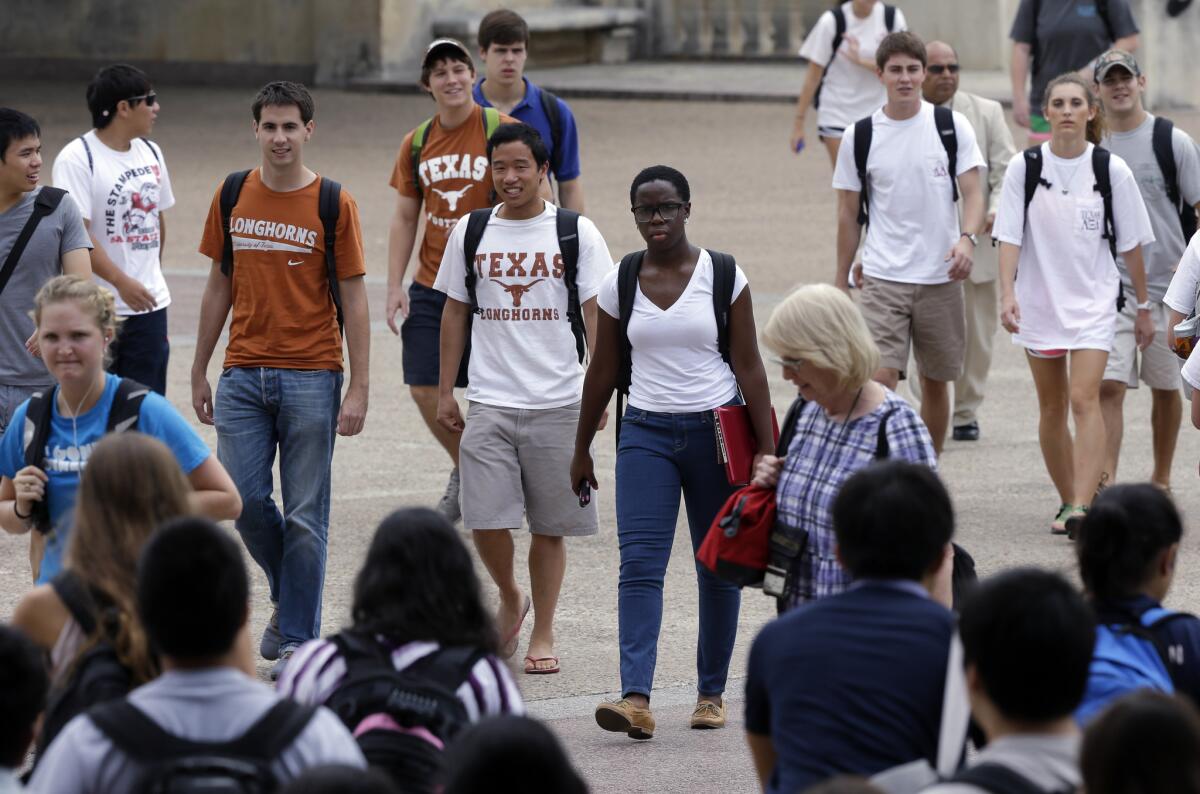Editorial: Why another look at affirmative action?

Students walk through campus at the University of Texas at Austin in September of 2012.
- Share via
Since 2003, when the Supreme Court last ruled that state universities may take race into account in their admissions policies without violating the Constitution, opponents of affirmative action have worked tirelessly to have the court revisit the issue. They were jubilant this week when the justices announced that they would entertain a second challenge to racial preferences at the University of Texas’ flagship campus in Austin. It’s ominous news for Americans who believe, as we do, that affirmative action is a valuable tool not only for ensuring diversity on campus but also for redressing deep-rooted racial inequalities.
Supporters of affirmative action held their breath in 2013, when the justices last considered the case of Abigail Fisher, a white student rejected by the university, who argued that admissions officials had pursued an unconstitutional policy of racial preference. Fisher had not finished in the top 10% of her high school class, the route by which most of the university’s freshman class attained admittance, but she hoped to be admitted through a secondary process of “holistic” review, in which the race of an applicant could be one factor. Although students of all races could be considered in the holistic review, the policy allowed the university to admit talented minority students from high-achieving districts who weren’t in the top 10% of their class.
But rather than rule on the merits in Fisher’s case, the justices sent it back to the U.S. 5th Circuit Court of Appeals with instructions to decide for itself — and not rely on the university’s assurances — whether racial preferences were narrowly tailored to achieve the “educational benefits of diversity.” Last summer the appeals court reconsidered the case and reiterated that the admissions plan was constitutional.
That should have been the end of the story. But now at least four Supreme Court justices have concluded that the court should intervene again in the now-ancient Fisher case. Some clearly hope that this time around the court will endorse Justice Clarence Thomas’ extreme view that “a state’s use of race in higher education admissions decisions is categorically prohibited by the equal protection clause” of the 14th Amendment.
That concerns supporters of affirmative action, especially in light of the replacement of Justice Sandra Day O’Connor, the author of the 2003 decision, with Justice Samuel A. Alito Jr., a George W. Bush appointee. But rejection of all use of race is not the only possible result.
The court might rule instead that, once a state university has achieved a diverse student body through a program like Texas’ 10% plan, explicit consideration of race is unnecessary — and therefore unconstitutional. That, too, would be a setback. The best outcome would be for a majority of the court to affirm the legality of what the University of Texas did — and then stop micromanaging university admissions policies.
Follow the Opinion section on Twitter @latimesopinion and Facebook
More to Read
Sign up for Essential California
The most important California stories and recommendations in your inbox every morning.
You may occasionally receive promotional content from the Los Angeles Times.













